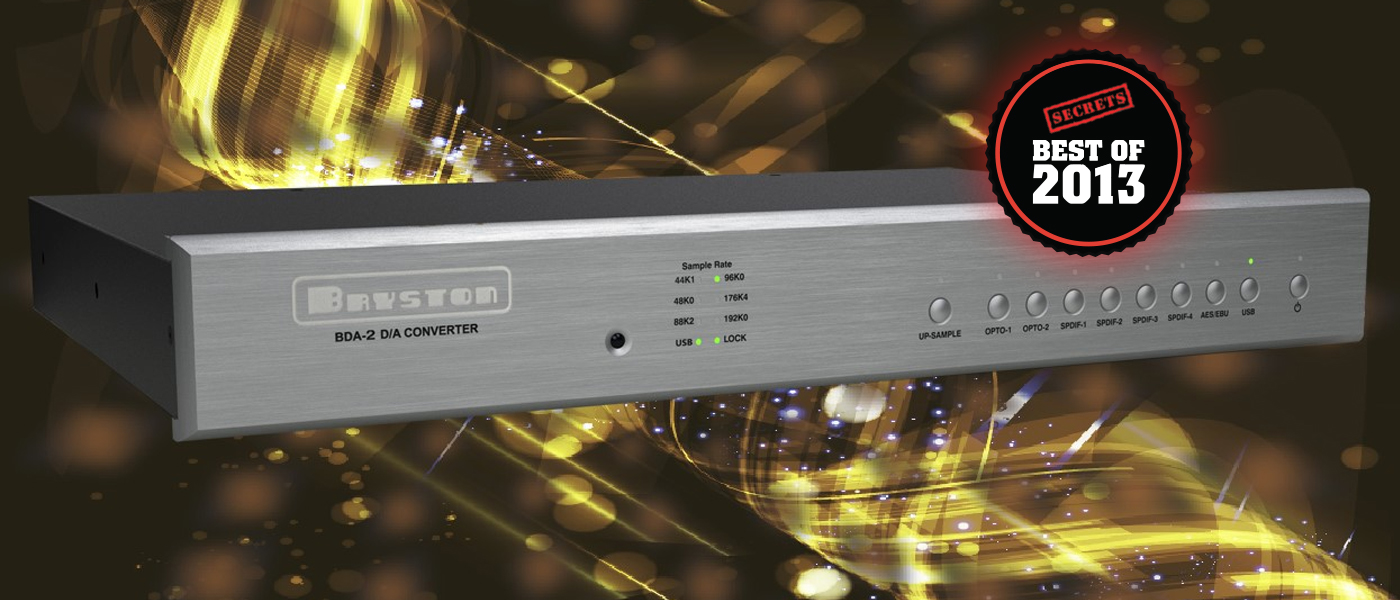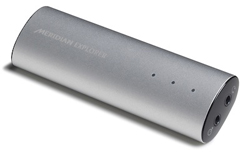

Introduction
Computer audio is all the rage now, with many people moving their entire digital collections to music servers, and the laptop taking the place of the CD player in many systems. The technologies behind USB DACs have evolved rapidly to where the interface is now on the same level as Coaxial or Optical interfaces. One area that hasn’t been addressed as well is the portable audio market, as most USB DACs are rack-sized components that require a wall power supply. This is certainly not a convenient option for those of us that want high-resolution audio on the go.
At this year’s CES, Meridian gave us a special sneak preview behind closed doors of their new portable DAC, the Explorer. A small, USB powered, 24/192 DAC housed in a stylish silver chassis, it certainly had the look of a solution for those of us that want to take our high-resolution music with us. Long known for their high-end products, this also came in at a very different price point for Meridian: $299. Could a high-end DAC be designed and manufactured in England and still hit this price point without sacrificing quality? We certainly wanted to find out!
Meridian explorer usb DAC SPECIFICATIONS
- Design: 24/192 USB DAC
- Digital Inputs: USB 2.0 (Asynchronous)
- Analog Outputs: 3.5mm Headphone, 3.5mm Line Level, 3.5mm Mini Optical
- Dimensions: 4″ H x 1.25″ W x 0.7″ D
- Weight: 1.76 oz.
- MSRP: $299 USD
- Meridian
- SECRETS Tags: Meridian, DAC, PCM, USB, USB DAC, Audio
The Design and Setup
The Meridian Explorer is tiny enough to fit in your hand, or pocket and looks quite unassuming for what it is capable of. There is a Mini-USB input for connecting to your PC with the included cable, and dual 3.5mm outputs. One 3.5mm output is a variable level headphone jack for you to connect your headphones straight to. The other 3.5mm jack serves a dual purpose: With a 3.5mm to RCA adapter it functions as a fixed 2V line output for your stereo, or with a MiniToslink to Toslink optical adapter it turns the Meridian into a USB to Optical converter. While that bypasses a lot of the functionality of the Explorer, it does fill a role for many people.
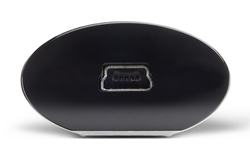
Having the Explorer connect via a separate USB cable might seem a bit cumbersome at first, but if you use a laptop, having a device stick out several inches from the side is annoying and potentially dangerous to your equipment if accidentally wacked. It also puts stress on the USB port once you add a hefty, high quality analog cable to the mix. Having a cable connection from computer to the Meridian Explorer is clearly the best way to go and, if it makes you feel better, you can then experiment with stupidly expensive USB cables.
The front of the Explorer has three white LEDs on it to indicate your current sample rate. The first indicates 44.1 or 48 kHz, the second 88.2 or 96 kHz, and the final 176.4 or 192 kHz. There are dual oscillators inside the Explorer to support both 44.1 kHz and 48 kHz based sample rates without adding an extra conversion step, maintaining the most accurate audio as possible. The optical output only supports 96 kHz sample rates, but the analog outputs will do full 24/192 audio.
As a Class 2, Asynchronous USB Audio device, those people using a Macintosh computer need to simply plug it in to start enjoying high-resolution audio. No drivers are necessary and the Explorer is fully powered off the USB bus. Windows users will need to install a driver provided by Meridian which allows for ASIO compatibility, allowing bit-perfect audio from your computer.
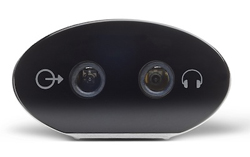
In Use
My first test of the Meridian Explorer is with the new Sennheiser Momentum headphones connected directly into the headphone output. The low noise floor is immediately apparent as cranking up the volume on a 24/96 recording of the Goldberg Variations revealed nothing more than the piano solo. Each note has body and dimension through the Sennheisers. On the 24/96, 2012 remaster of Smashing Pumpkin’s Mellon Collie and the Infinite Sadness the sounds is as rich and smooth as butter, a quality I never heard in the CD release. The Meridian Explorer injects lovely, analog-like warmth to the digital files stored on a hard disk that I found hard to argue with.
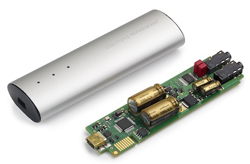
The Meridian Explorer may be entry level priced, but I wanted to see how it performed with some higher end gear. To do so, I fed the fixed line level out to a Burson Soloist headphone amp and listened through Audeze LCD3 headphones. The analog signal produced by the Meridian Explorer immediately makes me giddy with excitement. Tracks from the live concert album Inni by Sigur Ros only sounded better as I cranked the Burson Soloist louder and louder. Jonsi’s voice can be harsh on poor equipment, but the Meridian shows no signs of that. R&B music can often sound heavy at the bottom and hot at the top, with the entire midrange being forgotten about. A few tracks from Alicia Keys and Kanye leave that notion at the door. Lyrics are clear and balanced with barely a hint of sibilance. The aggressive low end is energetic and controlled.
Lossless ripped CD audio, something we all have a large abundance of in our collections, is given new life on the Meridian Explorer. I simply let Foobar shuffle through my entire collection and every song from Norah Jones to Sufjan Stevens sounds lively, open, and welcoming.
Soundstaging on the 24/192 version of Norah Jones’ Not Too Late is wide open in all directions. A guitar is not flat and neither is the sound that emanates in all directions from it. The added resolution does wonders for the dimensionality of music, adding depth to both the placement of instruments, as well as the sound they create. The 16/44.1 version has less dynamic range, but it is especially notable in Norah’s voice, which struggled to feel free at peak crescendos. I look forward to the day my entire music collection is stored in a high resolution format.
On the Bench
The Meridian Explorer DAC was tested using a MacBook running BitPerfect over iTunes as a source to make sure nothing was resampled or otherwise sent at anything than the original bitrate. From there the fixed line output was fed to a Lynx Two card on a PC running SpectraPlus to provide the data analysis.
On a 1 kHz test tone with CD quality audio, distortion is very low at 0.001% THD+N. Even order harmonics are larger than odd order ones, but even those are well over 100 dB below the fundamental frequency.
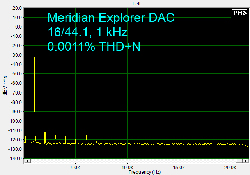
With a 10 kHz tone, the THD+N rose to 0.0014%, but we still have very close to 100 dB of dynamic range available here, and a very low noise floor that is over 120 dB below the fundamental.
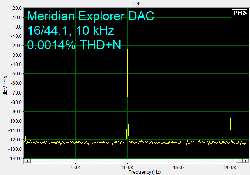
With 60 Hz and 7000 Hz IMD test tones, the IMD is very, very low at 0.0006%, and if there is a 14 kHz harmonic, I can’t see it. The noise floor is still over 120 dB down, offering really excellent performance.

With 19000 Hz and 20000 Hz IMD test tones we do finally see some sidebands that are visible, and a little B-A peak down at 1 kHz. That peak is almost 100 dB below the test tones, but the sidebands are only around 80 dB down. It is still very nice, but not as amazing as the first couple of tests.

Stepping up to 24/96 Test Tones, we see a bit more THD+N with the 1 kHz test, and there is a bit more noise present in the spectrum as well. Once again the even harmonics are more prevalent than the odd harmonics. The main reason for the noisier looking spectrum is that the noise floor is now down below 130 dB instead of 120 dB, letting more actual noise be visible.

The 10 kHz tone shows slightly different results, with the odd harmonics being more prevalent than the even ones, and THD+N rises up to 0.0038% this time. Overall the noise floor is very low, but the 10 kHz peak itself is a little slower to raise and fall.

Once we move up to 24/96 on the 60-7000 IMD test we can see the 14 kHz spike, it was just obscured by the noise floor before. It won’t be any more relevant this time, as it is still over 120 dB down, but it does exist. IMD remains incredible low, just like it was at CD resolution.
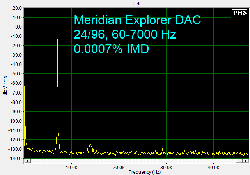
With the 19000-20000 IMD test the results also look the same, only with a lower noise floor. The A+B peak is present and visible but around 90 dB below the primary tones.

Moving up to 24/192 sourced files, we see very similar performance at 1 kHz as we did with 24/96 files. The noise floor remains around the same level, as does the dynamic range. The one thing we can see is a peak way out at 65 kHz, though that appears in every 24/192 test so it could be background line noise that is showing up at this resolution, or an artifact from the Meridian, but again it is so low and outside the audible range that I don’t worry about it.
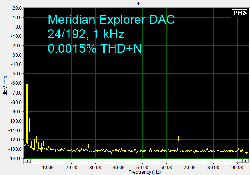
With the 10 kHz tone at 24-192 we see data almost identical to at 24-96, with even order harmonics being lower than odd order, though the noise floor is a bit higher than with 24/96 test tones.

The 60-7000 IMD test continues to perform very well, with that 14 kHz bump almost hidden away again. The IMD level is incredibly low, just like it was with prior IMD tests.
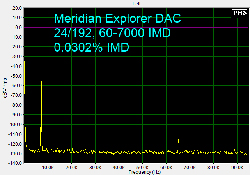
The 19000-20000 IMD test again has a B-A peak at around 95 dB below the primary tones, and sidepeaks at 80 dB below them.

Overall the Explorer does well on all of the bench tests, 24/96, 24/192, and CD Audio. The noise floor is clearly better with the higher resolution content, and not at the expense of any of the other bench test measurements that I could see. A very fine DAC for playing back all your high resolution audio files.
Conclusions
I have been looking for a simple, affordable way to use my laptop as a source at home and at the office without sacrificing quality. Given the increased availability of 24/192 files, I felt the need to have that playback ability and that greatly lowered the number of choices on the market. That is, until the Meridian Explorer became available. When Meridian first showed us the Explorer in Las Vegas, I was cautiously excited. I was convinced a product from Meridian would be priced out of the affordable zone I wanted to stay in. We were taken aback by the $299 price tag for a piece of Meridian equipment. As it turns out, sacrificing quality to meet a low price was never an option for the folks at Meridian. It may be slim and light, but the Explorer is well built and you won’t have any trouble bringing this with your laptop to work or on travels. Best of all, you won’t have to sacrifice on sound quality when listening to your music collection. At $299? My highest recommendation.


